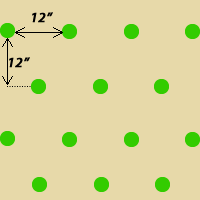FAQs
What variety of Zoysia do you sell?
ZoysiaPlug.com sells 100% Zenith Zoysia plugs. Our plugs are individually grown and never cut from the field.
Do you ship year round? When can I expect my plugs?
We do ship year round. Our Zoysia plugs are grown in climate controlled greenhouses. This means that they are ready to plant at arrival. We ship Monday-Friday (excluding holidays) and most orders are delivered 2-4 days after placing the order.
Can I put Zoysia plugs into an existing lawn?
For the most part, yes. If your lawn is Bermudagrass, you’ll need to kill it off first as it will be too competitive with the plugs. Roundup is the herbicide of choice.
How many plugs will I need?

This depends on two things: the area that you are intending to plant and the density you’d like to plant the plugs. First, calculate your total square footage. Measure the length and width of the area and multiply the two numbers together to get the total square footage of the area.
We usually recommend a density of 1 plug per square foot (which should take about a year to fully establish in the transition zone, shorter if you are further south). If you know your square footage, use our plug calculator to determine the number of plugs to order.
How often will I need to mow?
One of Zoysia’s main benefits is that it doesn’t need frequent mowing. In fact, you might only need to mow your Zoysia once every two weeks to once a month when it’s established.
What’s the best mowing height?
Set your mower blade to anywhere from 1.5 inches to 3 inches. We feel this is the ideal height range for our Zoysiagrass, with about 2 inches being about perfect for most lawns.
What type of mower should I use?
Reel or rotary, it is up to you. Zoysia does exceptionally well with reel mowers, but rotaries work fine too. Just make sure the blades are sharp as you want to cut your grass, not tear it.
When is the best time to plant Zoysia?
Zoysia is a warm season grass, meaning that it grows best during the warmer months of the year. The best time to plant it is from late spring, about when you’d plant a vegetable garden, until one month before the first frost. Zoysiagrass goes dormant after the first frost so we recommend installing it before this so it has time to establish before winter. Read more...
I’ve heard that Zoysia is prone to thatch. Is this true, and if so, how can I avoid it?
Just about all grasses will develop thatch over time and especially if not properly taken care of. With Zoysia, thatch can develop if it’s not mowed frequently enough and if it’s over-watered and over-fertilized. Mow your lawn at the recommended frequency and follow guidelines for watering and fertilizing, and you’ll have a happy, healthy Zoysia lawn with little thatch.
That said, your Zoysia lawn will eventually develop thatch. When it gets to over 1/2 inch thick, you should remove it with a combination of topdressing and dethatching. If you do have to dethatch, use a vertical mower or aerator. Power rakes are not effective on Zoysiagrass.
How much watering will I need to do?
Established Zoysiagrass needs very little water. During an extended drought it might turn brown but it will not die. We recommend watering on an “as-needed” basis, or just when the grass shows signs of getting stressed out—it might turn a dull bluish-gray color and the leaves might roll or wilt.
When your Zoysiagrass needs water, water it deeply. Apply enough so that the soil is wet to 6 to 8 inches deep.
Do I have to worry about pests with Zoysiagrass?
Zoysia is a tough grass and is pretty tolerant of most insects and diseases. That said, even the toughest grass can develop problems if not taken care of correctly. Following recommendations for mowing, watering, and fertilizing is the best way to keep your Zoysiagrass lawn happy and healthy. If problems do arise, work to identify them quickly—you might need to contact your local county extension agency or do some Internet research for this—and take the appropriate measures. If the problems are caused by incorrect cultural practices (this is almost always the case), correct them.
Is Zoysia really weed free?
Zoysia is a very dense growing grass and competes for root space meaning that most weeds won't survive. It is still beneficial to apply a pre-emergent for at least the first two growing seasons. Remember, these plugs have to fill in and weeds getting in the way will slow that outward growth. Check out Our Blog for a post about Zoysiagrass safe weed treatments!

